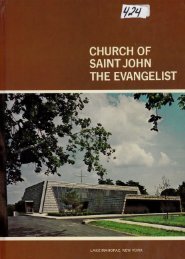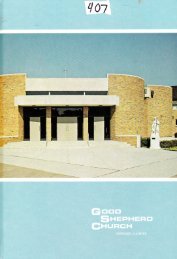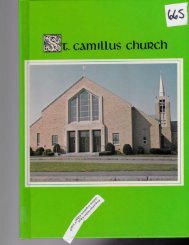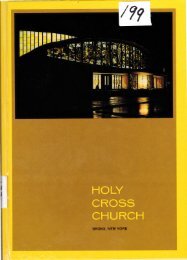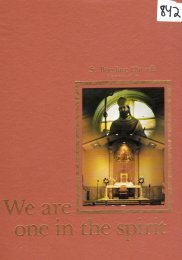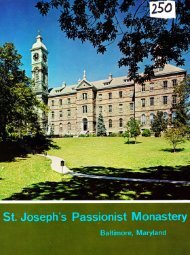Untitled - Digitizing America
Untitled - Digitizing America
Untitled - Digitizing America
Create successful ePaper yourself
Turn your PDF publications into a flip-book with our unique Google optimized e-Paper software.
And so it seems likely that the first person to<br />
preach our faith in this country was a layman.<br />
The travels of Don Hemando de Soto during the<br />
1540's left bodies of hundreds of the martyred<br />
faithful along river banks and wooded trails, but no<br />
permanent settlements.<br />
<strong>America</strong>'s first recognized martyr was a saintly<br />
Franciscan. Father Juan de Padilla, who had suffered<br />
with Francisco Vasquez de Coronado the<br />
miseries and disappointment of fortune-hunting<br />
journeys over ourwestern states, stayed behind to<br />
do mission work among the Kansas redmen. He<br />
had great success in converting the Quivira lndians,<br />
but was unaware that when he moved on to<br />
Christianize others they would consider his association<br />
with their enemies as traitorous.ln 1542,<br />
he was ambushed and murdered, the arrows of<br />
martyrdom repeatedly piercing his body as he<br />
knelt on the Kansas prairie, facing his assassins.<br />
ln 1549, Father Luis Cancer de Barbastro, convinced<br />
his missionary endeavors would prove<br />
fruitful if he could reach lndians not previously<br />
assailed by Spanish weapons, set out, accompanied<br />
by three other Dominicans, on an unarmed<br />
voyage from Vera Cruz, Mexico. Unfortunately,<br />
the ship's captain had paid little heed to his landing<br />
orders and brought the missionaries to the borders<br />
of a Floridian lndian village where hatred for the<br />
white man had seethed since former encounters<br />
with armed Spanish soldiers of fortune. A<br />
treacherous plot in which the natives feigned<br />
friendship led to the cruel deaths of Father Cancer<br />
and two of his priestly friends-another typical<br />
chapter in the story of the Spanish pilgrims.<br />
It was the multiplicity of these devastating events<br />
that caused King Philip ll, in 1561, to cease operations<br />
in exploring this part of the New World-a<br />
decision not easily made.<br />
Christianizing The Indians<br />
ing Philip was forced to recant<br />
his decision when French forces threatened<br />
Spanish treasure fleets. ln March of 1565 he<br />
commissioned Pedro Menendez de Aviles, Captain<br />
General of the Indies Fleet, to establish a<br />
Floridian fort incorporating a religious mission.<br />
When Menendez finally located the French base<br />
in September and then established his own, he<br />
named the harbor "St. Augustine." The first pastor<br />
of the future United States, Father Francisco<br />
Lopez de Mendoza Grajales, offered there a Solemn<br />
Mass in honor of the Nativity of the Blessed<br />
Virgin Mary, on this feast day, September 8th,<br />
bringing together Spaniards and lndians in the first<br />
communal Thanksgiving of our country's first<br />
permanent settlement. lt also marked the inception<br />
of the Parish of St. Augustine.<br />
Menendez, while awaiting additional Spanish<br />
Jesuits, traveled the Florida coasts erecting<br />
crosses and leaving behind lay instructors at many<br />
points, particularly those where military outposts<br />
were established.<br />
When more Spanish Jesuits came to the New<br />
World, some attempted to establish Catholicism in<br />
the Chesapeake Bay area while traversing this<br />
region in 1570-72. The early Spanish explorers<br />
called the Chesapeake Bay La Bahia de la Madre<br />
de Dios, the Bay of the Mother of God. A number of<br />
them were murdered by supposedly friendly lndians;<br />
the rest were withdrawn.




